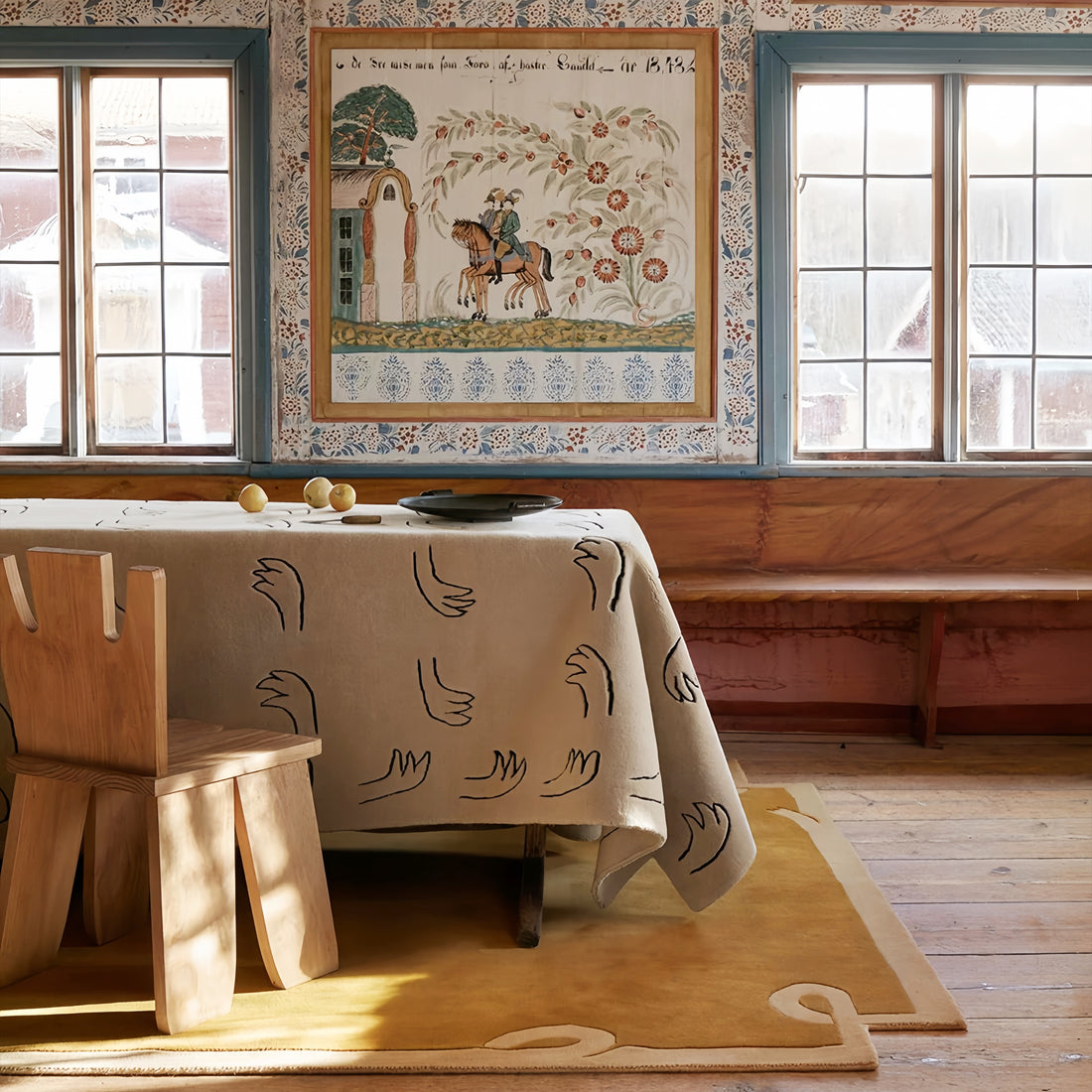Living room rugs add a wonderful touch of colour and warmth to the room. It is important to keep them clean and odour-free.

Vacuuming and scrubbing rugs are easy when you use the right cleaners. There are natural cleaners like baking soda and white vinegar that work well.
Before using any cleaning solution, test the rug for colourfastness in an inconspicuous area.
Vacuum
Vacuuming your rug regularly helps remove loose dirt and debris, extending its life and making it more pleasant to walk on. It's best to vacuum a woven rug with a furniture attachment and a brush or upholstery tool. When cleaning, make sure you go perpendicular to the pile direction; this will help maintain your rug's shape over time. Ideally, you should vacuum your rug weekly. It's also smart to vacuum the back of your rugs at least once every other month, as dirt tends to collect on the back.
Area rugs need more frequent care than wall-to-wall carpeting because they tend to collect more dust and are susceptible to staining from food and beverages. Depending on the amount of traffic in your home and the material your area rugs are made from, you may need to do a deep clean every other week or once or twice a year. If your rug is made of natural fibres (like wool rug), it needs to be cleaned gently with cold water; synthetic rugs can withstand hotter processes and can handle stronger cleaners.
The first step in washing your rug is to vacuum it, and make sure you get all the dirt and hair from both sides. Then, if it's safe, roll it up and take it outside to shake and beat out as much dirt as you can. Large rug is heavy, so get a friend to help you with this part. If it's not possible to take your rugs outdoors, you can use the bathtub for safer and more controlled results.
Mix a solution of your choice, such as a common wool cleaning detergent, or even a simple mixture of a teaspoon of natural detergent and a teaspoon of white vinegar mixed with a quart of cool water. Dip a sponge in the solution and blot it over the rug, working in sections. When you're done, empty the bucket and refill it with clean water, moisten a fresh sponge, and continue blotting until all of the soap is removed from your rug.
Once all of the soap is removed, allow your rug to air dry outside or in a well-ventilated room. Alternatively, you can use the dryer on a cool setting or in your bathroom, again with a sponge and clean, cool water.
Baking Soda
Baking soda (or bicarbonate of soda) is an affordable, all-purpose household item that can be used to clean many things around the home, including rugs. It has natural absorbing properties and works well to remove both stains and smells from rugs. The general method for removing both stains and odours from a rug is to apply baking soda in a generous amount over the entire surface area of the rug, paying special attention to areas that are most affected by odours or stains. Then, let it sit for a few hours or overnight so that the baking soda can absorb both the stain and the odour. Once the odour or stain has been absorbed, simply vacuum up the baking soda to restore the carpet to its original condition.
Greasy stains require slightly different treatment from non-greasy stains because they tend to have a more oily and fatty residue. To remove a greasy stain from a rug, first use a paper towel to blot the area to soak up as much of the grease and liquid as possible. Then sprinkle a generous amount of baking soda over the entire area of the stain. For best results, use a shaker bottle to make it easier to apply the baking soda. After sprinkling the baking soda, wait for about 3 hours or until you can no longer smell the stain, and then vacuum. This should completely remove the greasy stain and its associated odour from the rug.
Another common use for baking soda is to get rid of odours caused by pets. Pets are usually very lovable, but they can also leave not-so-loveable odours in your carpets and rugs. For odours that stem from "accidents," you can try sprinkling the rug with baking soda and letting it sit for about 3 hours, or overnight for stubborn stains. Then vacuum the rug and repeat as needed until the odour is gone.
For a general odour in the house, you can spray a mixture of water and vinegar to deodourize a room or area. The ratio is generally 1 part water, 1 part vinegar, and 2 parts baking soda. You can use a spray bottle to apply the mixture, or you can combine the ingredients in a bowl or cup. This mixture can be sprayed directly on the odour source, or it can be brushed into the carpet fibres for an even stronger effect.
White Vinegar
When it comes to cleaning rugs, white vinegar is a natural and inexpensive solution. Unlike store-bought carpet cleaners, it doesn’t contain harmful chemicals and won’t leave your rugs feeling damp or sticky. Vinegar is also an acid, which helps neutralise certain types of smells and bad odours.
When used properly, vinegar can lift and remove stains from your rugs while keeping them soft and smelling fresh. To use it, start by spraying your rug with a solution made of equal parts water and vinegar. Then, use a clean cloth or brush to work the solution into the rug. Make sure you scrub gently to avoid damaging the fibres.
If you’re dealing with a tough stain, try adding baking soda to your vinegar solution. The alkaline baking soda reacts with the acidic vinegar to create a safe and oxygenated gas that lifts the stain from your carpet. This technique is particularly effective at removing greasy stains, which are caused by cooking oils and butter, machine lubricant, and more.
You can also try scrubbing your rugs with a mixture of vinegar and dishwashing detergent to lift stains and deodorise them. This method is effective for most rugs, but it’s best to spot-treat dark or patterned rugs before you apply this solution. For best results, add a little baking soda to the mixture, as it helps to lift greasy stains without leaving behind any residue.
For a more intensive cleaning, combine your vinegar and baking soda with an all-purpose fabric cleaner. This is one of the most effective and economical ways to clean your rugs and will leave them looking and smelling great. Mix equal parts of vinegar and fabric cleaner, then apply it to a stain or heavily soiled area of your rug. Scrub the area thoroughly using a soft brush or sponge, then rinse and dry your rug.
If you have a pet, it’s important to keep your rugs clean to prevent them from attracting and harbouring fleas. Fleas can cause severe skin problems for pets and humans alike, so preventing them from entering your home is crucial. Vacuuming your rugs at least twice a week is the best way to do this, but sometimes you may need to use other home remedies or professional carpet cleaning to get rid of persistent and stubborn stains.
Carpet Shampoo
Rugs need regular cleaning to remove dirt and debris, but sometimes they also require a deeper clean. This is especially true if you have pets or children that tend to track in mud and dirt. A carpet shampooer is a great option for deep-cleaning rugs, especially those made of natural fibres like wool or cotton and synthetic materials like jute, sisal, polyester, polypropylene, and sheepskin. However, before using a carpet shampoo on any rug, you should read the care tag to make sure the chemicals are safe for the fibres.
A carpet shampooer is a machine that pumps water and carpet cleaner into the rug and then extracts both the cleaner and the dirty water. You can find carpet shampooers at home improvement stores or online. Look for a model with settings for light, normal, and deep cleaning, as different options may be appropriate for your rug.
If you're going to use a rug shampooer on your own, start by removing furniture and vacuuming the rug. Be sure to vacuum both sides of the rug, and flip it over to clean the underside as well. If the rug is very large, it's a good idea to have someone help you move and flip it.
After you've done a full cleaning with the rug shampooer, be sure to do a second rinse with white vinegar. This will neutralise the soap residue that's left behind on the carpet fibres, so it won't attract more dirt. After you've rinsed the rug, blot it dry as much as possible to prevent mould or mildew.
If you have a small, room-size natural rug that's colourfast and machine-washable, wash it in the washing machine on the gentle cycle with cold or warm water, depending on the care label. If your rug is larger or is made of a less-colourfast material, try using a commercial carpet cleaning foam on the stain. Apply the product according to its directions, and then rinse thoroughly. Allow the rug to dry completely before replacing it on the floor. Alternatively, hang the rug to air-dry on a rack or on the back of a fence, and be sure to keep it away from moisture sources.


















































